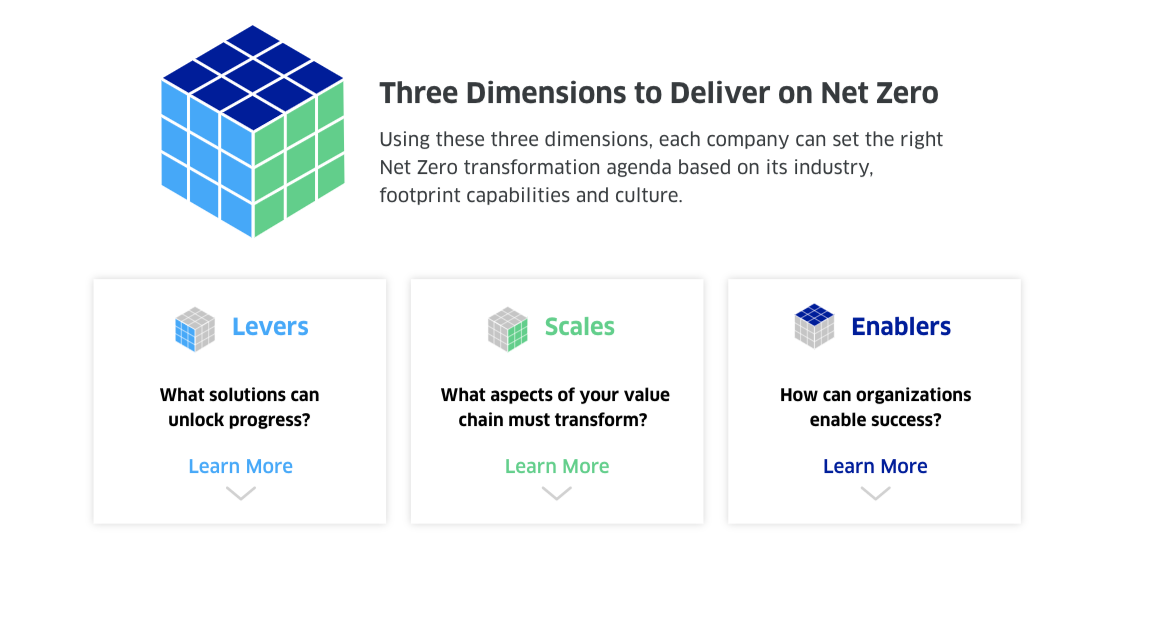Companies news
Charting Your Transformation Journey To Net Zero Carbon

Today, more than 3,000 companies and almost 175 large investors have joined cities and regions around the world to announce Net Zero targets with many joining ‘The Race to Zero’ during the last 12 months alone. According to a new ENGIE Impact survey of 400 executives of large multinational organizations, 77% of executives consider themselves at least moderately successful in executing their sustainability programs. These are encouraging signs. However, most companies are only at the beginning of their decarbonization journeys. Almost all executives acknowledge seeing mixed results from their efforts and that there is room for improvement.
Indeed, many of these organizations are quickly realizing the magnitude of change necessary. Achieving Net Zero implies a transformation journey far beyond the incremental change companies are accustomed to.

While each organization’s Net Zero transformation journey will be unique, we’ve found that successful decarbonization is fundamentally anchored around three dimensions: the decarbonization levers organizations deploy, the scales at which they engage and transform operations, and the enablers that serve to unlock opportunities and accelerate change.
Where are companies falling short?
More and more leading organizations are identifying the right levers of decarbonization, and, increasingly, the scales at which they will need to operate. However, few have put the necessary enablers in place to deploy these solutions at the pace required. Without fully considering each of the three dimensions of Net Zero transformation, companies are likely to fall short of achieving their ambitious targets.
In this piece, we explore the fundamental questions underpinning each of the three dimensions and show how they came to life in companies from three very different sectors: industrial manufacturing, technology and utility.
Understanding The Three Dimensions Of Net Zero Transformation: Levers, Scales And Enablers
Levers are the solutions to achieve decarbonization targets. The right solutions will address the most material emissions sources across an organization’s value chain. These levers could include everything from green energy supply and energy efficiency to carbon offsets and zero-emissions fleets.
Consider questions such as:
- How much renewable energy will we need to purchase and by when?
- When is the right time to invest in emerging fuel sources such as green hydrogen?
- How should offsetting be incorporated into the broader decarbonization strategy?
Scales define the parts of your value chain that should be the focus of your decarbonization efforts. Choosing the right scale depends on the unique characteristics of an organization, such as the distribution of its carbon footprint, company culture, resources, and ambition. As organizations mature, their approach will evolve, eventually reaching all the scales to deliver full Net Zero transformation. Scales include individual sites, business units, suppliers, and customers.
Consider questions such as:
- Where in our value chain are emissions most concentrated?
- Would a decentralized or centralized approach most effectively drive change?
- Which areas of the business will be best suited to the proposed technologies and practices?
Enablers unlock opportunities and accelerate decarbonization of an organization. They encompass everything from governance models to financing mechanisms and digital tools. Ultimately, enablers determine the effectiveness of an organization’s Net Zero transformation.
Consider questions such as:
- Is our Net Zero ambition aligned with the vision and strategy of the business?
- What governance structures will drive accountability across the organization?
- How can we deploy innovative financing mechanisms to accelerate our efforts?
This three-dimensional methodology offers organizations the flexibility and rigor to chart the right path towards successful Net Zero transformation. This helps to tailor the levers, scales, and enablers to industry, footprint, capabilities and culture—and to evolve them based on progress towards Net Zero goals and the ever-changing business environment.
See how these dimensions manifested in the case of an industrial manufacturer, a technology company and a utility.
How Can You Achieve Net Zero?
Achieving Net Zero requires organizations to commit to a sustainability journey far beyond the incremental change companies are accustomed to. These changes need to include solutions for the entire value chain anchored around three dimensions: the decarbonization levers organizations deploy, the scales at which they engage and transform operations, and the enablers that serve to unlock opportunities and accelerate change.
An International Paper Company Tackles Hard-To-Decarbonize Operations
An international paper company set the ambitious goal to achieve Net Zero by 2050. Thermal energy needs accounted for 80% of its emissions. To decarbonize thermal, it needed a deep understanding of available technologies and corresponding cost curves, as well as creative ways to quickly mobilize the necessary capital and resources. The company's Net Zero transformation journey began with a clear articulation of the leadership’s ambition and strategy. A deep analysis of the emissions data is helping to determine when and how to deploy the decarbonization levers. The company has confidence in taking decarbonization actions with a clear roadmap in hand.
Scales
The company is focusing first on its core sites, with an eye toward a broader, company-wide emissions reduction trajectory.
Levers
After investigating various decarbonization levers, the company chose: green power and gas supply, energy efficiency, as well as on-site generation.
Enablers
With a clear roadmap in hand, the company’s next step is to understand the financing and contracting needs. It is also building a governance framework and delivery management process to track progress.
Going Behind The Scenes Of Netflix's Net Zero Strategy
On March 30, 2021, Netflix committed to achieving Net Zero greenhouse gas emissions by the end of 2022. The company hopes to influence the industry with implementing its sustainability strategy on an accelerated timeline. Netflix also wants to bring its audience along on its ambitious journey, communicating clearly about its science-based strategy and providing insight into complex topics such as the carbon impact of streaming. Netflix is building a strong internal team focused on setting strategy and ambition, green energy transition, and leveraging carbon offsetting.
Scales
Recognizing that half of Netflix’s footprint sits within the physical production of the content, the company is prioritizing its decarbonization efforts on its content production and operational sites. This encompasses its own facilities, where it has master lease agreements, and where it can influence corporate office leases.
Levers
With the scale defined, Netflix is implementing a range of decarbonization levers. It is optimizing energy efficiency, replacing fossil-fuel energy sources with electric power and purchasing 100% renewable energy in its own operations. For the remaining emissions, it has adopted a high-quality approach to offsetting, both conserving at-risk natural areas and removing carbon from the atmosphere by investing in the regeneration of natural ecosystems.
Enablers
Netflix is bringing together coalitions of industry peers, non-profits and other stakeholders to shape new science-based guidance. It saw quickly that some emission sources, for example, those associated with streaming, are difficult to calculate in the absence of guidance from leading standards and protocols.
ENGIE Accelerates Decarbonization Of The Energy Sector
In May 2021, ENGIE announced its ambition to become Net Zero by 2045, covering all emissions across its value chain. This long-term ambition is complemented by intermediary targets for 2025 and 2030 and the commitment to maintain a trajectory compatible with well below 2°C. ENGIE’s decarbonization ambition was anchored in its corporate purpose and long-term business strategy.
Scales
ENGIE’s ambition covers all emissions sources and as such requires acting along multiple scales. ENGIE’s strategy is focused on its core activities across various business units and geographies. At the same time, ENGIE is committed to engaging its suppliers of goods and services to effectively tackle procurement emissions. Finally, ENGIE made the additional commitment to contribute to the decarbonization of customers by 45Mt CO2e by 2030, from 20Mt CO2e in 2020.
Levers
Energy generation and sales comprise the bulk of ENGIE’s carbon footprint and, are, therefore, at the heart of ENGIE’s decarbonization strategy. Levers include growing renewable power generation, accelerating low-carbon distributed infrastructure, a complete coal phase out by 2027, reduction of gas unit load factors, and the switch to green gas and Carbon Capture and Storage. ENGIE is minimizing the use of carbon offsets, favoring high-quality projects close to its core activities.
Enablers
ENGIE is progressively driving change across the organization through various governance actions, including tying the CEO and executive team’s performance goals and compensation to carbon reductions; introducing carbon budgets to manage emissions across the main business entities and managing these jointly with capital allocation; and improving carbon accounting processes to better support management decisions. ENGIE is also actively engaging stakeholders, and in particular collaborators, suppliers, and clients through the launch of its Net Zero journey.
These company stories offer a snapshot of different transformation journeys. There are common lessons: companies can continue to achieve incremental progress by deploying the right decarbonization levers at scale. But that’s not good enough for those responding to climate change as today's reality—not a distant threat for the future. For corporate pledges to translate into urgent and decisive climate change action, companies must step up investments in the enablers of Net Zero transformation now.


